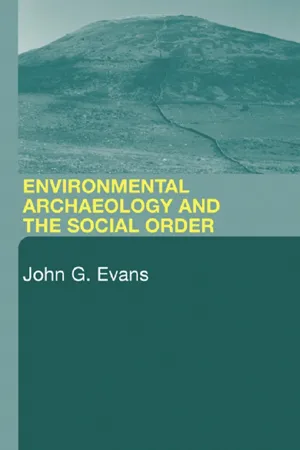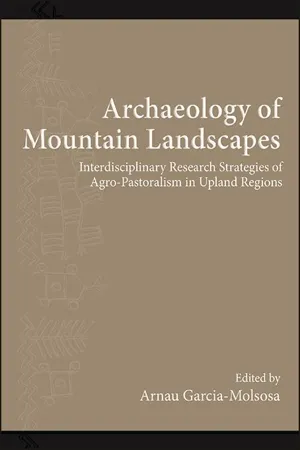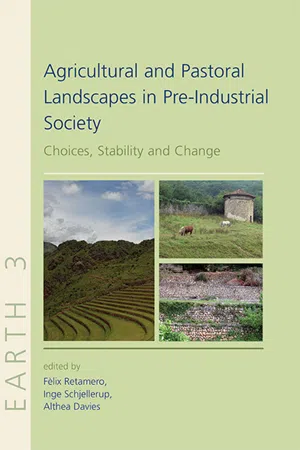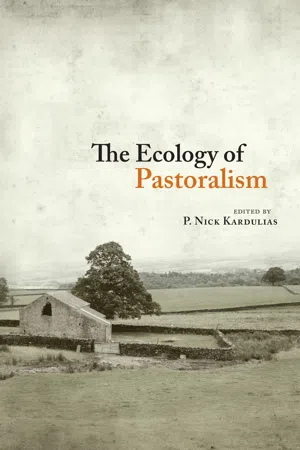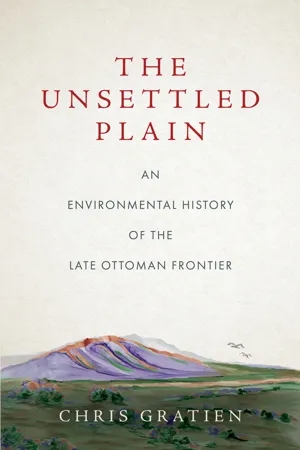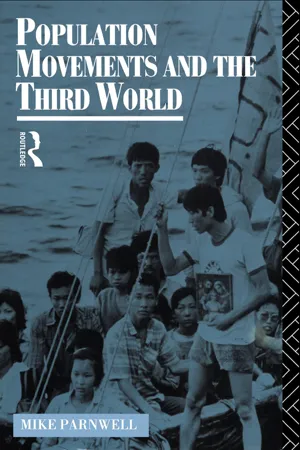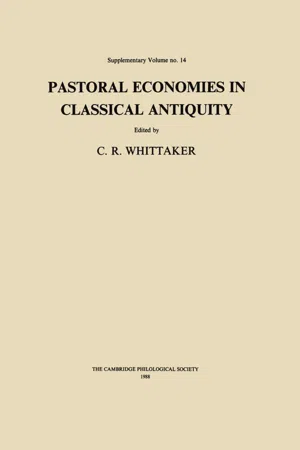Geography
Transhumance
Transhumance is the seasonal movement of livestock and people between fixed summer and winter pastures. This traditional practice is common in mountainous regions and helps to optimize grazing resources and minimize overgrazing. It is a sustainable way of utilizing natural resources and has significant cultural and economic importance for many communities.
Written by Perlego with AI-assistance
Related key terms
Related key terms
1 of 4
Related key terms
1 of 3
10 Key excerpts on "Transhumance"
- Eugene Costello, Eva Svensson, Eugene Costello, Eva Svensson(Authors)
- 2018(Publication Date)
- Routledge(Publisher)
Chapter 1Transhumant pastoralism in historic landscapes
Beginning a European perspective
Eugene Costello and Eva SvenssonTranshumance – a Concept Better to Discuss Than to Define?
Pastoralism offers a vast field of study, and within it transhumant practices represent an important range of past and contemporary human mobility strategies. In its widest sense, Transhumance may simply be described as the seasonal movement of livestock. The Oxford English Dictionary adds some environmental qualification to this by defining Transhumance as “the action or practice of moving livestock from one grazing ground to another in a seasonal cycle, typically to lowlands in winter and highlands in summer”. The wide-ranging geographic and social implications of such a definition mean, of course, that the study of transhumant practices permits a very wide perspective on human society, touching on themes as diverse as livestock management, economic responsiveness, social mobility and competition for land. Furthermore, use of the relative words ‘lowlands’ and ‘highlands’ means that a considerable proportion of the earth’s surface may be considered as potential settings for Transhumance. There are consequently many ways in which people might conceive of and define the practice, and there has not been one, but many transhumant pastoralisms in Europe during historical times.For ethnographers, who long dominated the field of historical Transhumance, it was diversity, not shared experiences and characteristics that were emphasised. The importance of ethnography and ethnographic documentation of transhumant pastoral regimes all over Europe on the eve of their demise cannot be overestimated. These records are now invaluable to historical archaeologists working with transhumant pastoralism, especially as the field is difficult to access with only archaeological methods. They also form narratives of their own, transmitting Transhumance as a pre-modern, out-dated mode of production located in the peripheries of mainstream and modern farming, and not as a rational agricultural practice. Another prominent feature of the ethnographic narratives on Transhumance is regionalisation, emphasising geographically bounded regional, and even local, characteristics and traditions as structuring principles. These regionalised approaches have often been combined with both nature determinism and the assumption that characteristics of a cultural system are more strongly accentuated in the peripheries than the centres (See below “Transhumance and pastoralism – an overview”, with references; Svensson, Chapter 2- eBook - ePub
- John G. Evans(Author)
- 2004(Publication Date)
- Routledge(Publisher)
8
Transhumance
This chapter is about Transhumance, the way people move animals around in relation to the seasonal availability of grazing land and usually within a broader farming system. More deeply, the aim is to understand how these movements play a part in people’s social lives, and especially how they bring together individuals of different age and gender groupings so that future life-cycle events may be learnt about. It is about meetings which are less frequent than those of a routine kind (school, workplace, home and recreation), which last for a few days or several weeks, and which are among strangers or at least among people who do not meet in daily life. These are associations that come about in relation to the annual subsistence cycle at particular times of the year and on journeys or when a part of a family is moving around.In broadening things in this way it may seem that Transhumance is superfluous to such a programme: other practices offer similar possibilities. We could examine systems of mobility like the student year, relationships between town and country, or the modern business world, each of which satisfies similar social functions. We might also show that there were relationships between some of these systems, as with solitude and simplicity in Transhumance as an antidote to the intense communality of city life, and both of these institutions – Transhumance and the city – developed in some areas at around the same time. But I want to focus on just one of these because the point is easier to make through exemplification.Another reason for looking at a single system is that it allows us to explore the relative importance of different influences in its development and perhaps reveal unexpected ones. In a book on environmental archaeology, Transhumance is particularly relevant because of the way it is seen as being at the service of environmental and economic imperatives. Transhumance is a strong construct even with people who do not practise it. There is an attraction in the idea of different transformations in a common subsistence structure; there is an attraction in Transhumance being a consolidation in farming of a practice that is natural to animal flocks and herds; and there is an appeal in the way early agriculture may have developed out of such a natural system (). Yet we should not necessarily deconstruct Transhumance in this way, for maybe, too, it was similarly used in the past. - eBook - ePub
SUNY series, The Institute for European and Mediterranean Archaeology Distinguished Monograph Series
Interdisciplinary Research Strategies of Agro-Pastoralism in Upland Regions
- Arnau Garcia-Molsosa, Arnau Garcia-Molsosa(Authors)
- 2023(Publication Date)
- SUNY Press(Publisher)
A central Tatra Park Project goal is to document seasonal migratory Transhumance between the park’s high montane, subalpine, and alpine environmental zones and lower mid mountains and foothills to the north. Transhumance refers to the economically (e.g., natural resource-based) driven, seasonal migration of animals and humans between ecologically and topographically varied landscapes within geographic regions. For Transhumance to be advantageous for a species (animal or human), a region should present a seasonally defined deficit of one or more important natural resources in one subregion and possess relatively greater resource abundance in another (usually adjacent) region or subregion in an alternate season. Both human and animal seasonal migrations associated with Transhumance can be classified as either horizontal, moving between geographic areas and eco-zones having limited rises or falls in elevation or vertical, involving more pronounced vertical ascents and descents (e.g., traveling between lower elevation valleys or plains and higher hills or mountains) (cf. Arnold and Greenfield 2006; Brunswig 2015:46–52; Carrer 2012, 2015; Geddes 1983; Hafner and Schwöer 2018). Seasonal movements between differing, adjacent eco-zones, as an example, migration into seacoast regions with summer season abundance of fish and sea mammals from inland winter camp areas or involving movement of hunting parties following migratory game herds from low-elevation mountain fall-winter-spring camps to high-tundra grazing land, reflect both the annual rhythm of human, animal, and plant cycles and their intimate economic codependency. Other types of natural resources, the presence of tool raw material (high-quality lithic stone or metal ores), seasonal concentrations of food and medicinal plants, mineral deposits (e.g., salt), and wild or domestic animal forage plants, can also contribute to the benefits of transhumant economic systems.Methods for inferring human Transhumance from archaeological and paleo-environmental records are diverse and frequently dependent on local and regional circumstances of geological and archaeological preservation. More common methods include chemical isotope ratios of carbon and nitrogen in human and animal bone and teeth, analysis of radiocarbon-dated bog and archaeological sediments for organic content, magnetic susceptibility, pollen, and charcoal content (associated with climate-related [e.g., natural] and anthropogenic [forest-clearing] fires), and transhumant migratory transfer of geographically sourced tool materials and mollusk shells outside their geologic origin locations (cf. Brunswig 2015:84–91; Dietre et al. 2014, 2016; Galop et al. 2013; Kienlin and Valde-Nowak 2002–2004; Leigh et al. 2016; Martin 2015; Nehlich et al. 2009; Rey et al. 2013; Riehl 2006). - eBook - ePub
Social and Ecological History of the Pyrenees
State, Market, and Landscape
- Ismael Vaccaro, Oriol Beltran(Authors)
- 2016(Publication Date)
- Routledge(Publisher)
Finally, despite the repeated announcements of its disappearance, the practice of Transhumance has continued up to now, even if the journeys are not always on foot. 6 Overall, in line with Roigé et al. (1995), the authors of this chapter see Transhumance as a strategy enabling pastures located in different ecological settings to be exploited in a complementary way throughout the annual cycle, in a particular social, economic, demographic, and political context. It is a historical activity but not one that can be explained as a survival from the past. Transhumance today is different from what it was 50 or 200 years ago: the people involved, the size of the flocks, the destinations and calendar of movements, the orientation and organization of production, and its relationship with other social and economic activities have all changed. Nevertheless, modern Transhumance cannot be understood solely in terms of the present, and must be seen in the light of the changes that came about in the Alta Ribagorga and the Pyrenees in the course of the 20 th century. For this reason, the context in which Transhumance is practised today and the processes of change it underwent in the course of the last century are outlined below. The geographical, economic, and demographic context The Alta Ribagorça is made up of the valleys that form the head of the Noguera Ribagorzana River, in the central part of the axial Pyrenees: the Barravés Valley with the Noguera Ribagorzana River, the Boí Valley with the Noguera de Tort River, the Castanesa Valley with the Baliera de Castanesa River and the Viu Valley with the stream of the same name. This is a high mountain area, with altitudes ranging from 800 metres at the bottom of the valleys up to over 3,000 metres at the peaks - eBook - ePub
Agricultural and Pastoral Landscapes in Pre-Industrial Society
Choices, Stability and Change
- Fèlix Retamero, Inge Schjellerup, Althea Davies, Inge Schjellerup, Althea Davies(Authors)
- 2014(Publication Date)
- Oxbow Books(Publisher)
Mesta organisation), as well as in Arles in Southern France, in the plains of the River Po or in the plains neighbouring the Apennines in Italy. However, as some examples here will show, the so-called Transhumance of livestock has also been a very common practice at smaller, local scales in most parts of Europe. It not only allows people to move the herbivores away from the fields, but also to exploit sometimes vast areas (ecologically) improper for cultivation, such as wetlands and bogs, woods or higher mountain slopes. In order to allow these tranhumances at various scales, European agro-pastoral societies have always elaborated very strict juridical systems defining local calendars for annual pastoral activities in terms of territorial allowances and bans. Here, precise local knowledge of the vegetation cycles of both cultivated and uncultivated areas tends to regulate the movements of livestock, especially in the cultivated areas between the end of the harvests and the beginning of a new vegetation cycle. Often (family) landownership can be more or less temporarily suspended by so-called ‘surface rights of common grazing’ when the fields are uncultivated or lie fallow. On the other hand, the grazing areas used during the agricultural season are often, but not always, collectively owned and herded. Especially in mountainous regions, the spatial separation of crops and pastures is vertically managed according to the different altitudes, sun exposures and geomorphologies. But also in less steep and even rather flat regions, the seasonal variations in, for example, precipitation or drought can determine the local pastoral areas like moorlands or river- and lakesides.The botanical characteristics of the cultivated crops as well as the ethological specificities of the animal breeds and species concerned, have often been locally selected and adapted and form specific, recognisable ensembles of agro-pastoral practice. These ensembles of domesticated cultivars and animal breeds also come to shape local landscapes through specific field patterns, physical or juridical divisions, paths, enclosures, roads and other developments such as irrigation or drainage. As various cases studied here show, the temporary removal of livestock from the cultivated areas, is written into the landscape by the existence of temporary habitats, livestock enclosures and other specific pastoral facilities like isolated hay-barns or watering places. - eBook - ePub
- P. Nick Kardulias, P. Nick Kardulias(Authors)
- 2015(Publication Date)
- University Press of Colorado(Publisher)
A village of permanent buildings occupied by all or part of the population all year, rather than a mobile tent camp[,] form the nucleus of a transhumant society. Although pastoral activities are one of the concerns of a transhumant community, agriculture nearly always remains the dominant interest. In other words, pastoral movements are limited in scale, usually take place in one valley system, and are undertaken by only a small proportion of the total population. None of these features are shared by pastoral nomads. (cited in Jones 2005 :358) Jones describes a transhumant society in northeast Afghanistan, which also fits the pattern in Hunza: Here in the region known as Nuristan the population resides in permanent villages around which are irrigated hill terraces for the production of wheat, maize, millet, and barley. . . The year begins in spring with the livestock (mostly goats, but also some sheep and cattle) being taken out of winter stables and herded up to the first pastures. The majority of the population resides in the village throughout the year. In autumn, when the harvest is complete, the livestock are brought back to the village area and go into winter quarters, where they are stall fed until spring. (Jones 1974 :22–38) Based on his fieldwork in Afghanistan, Dupree (1973 :164) has pointed out another distinction between Transhumance and pastoral nomadism. In Transhumance, mobility is vertical over short distances. In contrast, pastoral nomads are herdsmen who move over long distances;often but not always, their movement is horizontal (ibid.). As Bates and Rassam (1983 :111) have observed, the movement involves considerable distances because in the foothills and lowlands, pastures are situated further apart than they are in mountainous areas. The key factors that determine the number of animals herded and locations of encampments are the availability of pasture and water (ibid.) - eBook - ePub
Life in Medieval Landscapes
People and Places in the Middle Ages
- Sam Turner, Bob Silvester, Bob Silvester(Authors)
- 2011(Publication Date)
- Windgather Press(Publisher)
CHAPTER SEVEN
Shadows of Ghosts: Early Medieval Transhumants in Cornwall
Peter Herring
Appreciating pasturing supports understanding of all aspects of prehistoric and medieval rural life in south-west Britain (see Fox 1972; 1981; 1996; Herring 2004; 2008). Transhumance and the more attenuated forms of summer grazing that succeeded it, probably from around AD 1000, were important elements of the mixed farming systems that exploited the varied land of Cornwall: rolling lowlands in which lay most home farms and fields, and the deep wooded valleys, numerous marshes and scattered blocks of upland and coastal rough ground.Transhumance, the movement of people with their livestock to seasonal pastures, can be seen as a risk-reduction strategy that maximised grazing by exploiting seasonally available rough grass and herbage on the uplands, coast and wetlands, while removing livestock from open and unprotected home fields where crops and hay were being grown and saved (Ó Dhubhthaigh 1983–4, 49; Davies 1984–5, 77; Bil 1990, 45; Herring 1996a, 39; Fox 1996, 3; Ward 1997, 103–4). The Irish also maintained that the summer’s ‘change benefited the health and well-being of both the cattle and their guardians’ (Ó Danachair 1983–4, 36; Kelly 1998, 43; and see Gaffney 1959, 21). For a period in which the farming community is particularly difficult to pin down, the exploration of an activity that took communities and individuals to the landscape’s margins greatly enriches understanding of early medieval society. But owning and sharing, tending and caring, milking and shearing, knowing and fearing, living and moving among domesticated ungulates creates worlds and world views like no others, and it is these as much as the agrarian practice itself that this paper explores.It interweaves six strands of material studied broadly sequentially: toponymy, archaeology, palaeoecology, landscape history, cultural geography and ethnography. The last may seem least relevant, but early modern Irish Transhumance had close similarities with that of the seventh to twelfth centuries (Ó Danachair 1983–4, 40; Kelly 1998, 43–5). - eBook - ePub
The Unsettled Plain
An Environmental History of the Late Ottoman Frontier
- Chris Gratien(Author)
- 2022(Publication Date)
- Stanford University Press(Publisher)
251The distinction between nomadism and Transhumance had implicit racial connotations in Turkey. The transhumant population of Alagöz’s study consisted of those who were properly considered Turkish or from “the Turkish race.”252 The racial component of early republican interest in Yörüks, Türkmens, and the pastoralists of Anatolia was more explicitly stated in a 1941 study published by Alagöz’s colleague at Ankara University, an anthropologist named Kemal Güngör. His analysis of the Yörük populations of Southern Anatolia included not only information about way of life, economy, folklore, and traditions, but also extremely detailed anthropometric measurements from the various tribes he studied during field research in 1938–39.253 The studies of Alagöz and Güngör occurred during a pivotal moment in history that required qualifying Transhumance with ethnic or racial modifiers. As Soner Çağaptay notes, “the word nomad in the republican jargon was a euphemism for the Kurds, and the occasional Roma.”254 The definition of Transhumance employed by Alagöz rendered Turkish pastoralists essentially similar to all other Turkish citizens in origin, no more distant than the Parisian was from the Alpine villager. This distinction in turn rationalized the settlement laws aimed at Kurdish populations, conceptualized as the settlement of nomads who were deviant within the national culture and therefore a threat.255 The Dersim rebellion of 1937–38 was the culmination of such policies. In Dersim, the army waged war with largely pastoralist communities who resisted the 1934 Settlement Law and other measures aimed at pacifying Kurdish communities in Anatolia. The consequent military campaign was brutal. It employed aerial bombing, killing large numbers of people and displacing most of the population.256 - eBook - ePub
- Mike Parnwell(Author)
- 2006(Publication Date)
- Routledge(Publisher)
In many parts of the Third World patterns of population movement may be determined by seasonal climatic patterns, especially in areas where there has been limited investment in irrigation facilities, for example, which might otherwise reduce the dependence of agriculture on seasonal variations in rainfall. As we shall see in the following chapter, the response may take the form of the periodic movement of people between ecological zones, as is the case with pastoralists and some semi-nomadic groups. Elsewhere, seasonal lulls in farming activity may prompt people to move in search of short-term employment with which to supplement their earnings from agriculture. Much, of course, depends upon the seasonal availability of employment opportunities both within and outside the local area. Such forms of movement are synchronized with the farming cycle, with people seldom staying away from their home communities for more than a few months (unless their prolonged absence is desirable from a financial viewpoint). A much longer cycle of movement is practised by shifting cultivators who, because of ecological restrictions on the length of time they can farm a given area, may only return to that area once every ten to twenty years.Much employment-related migration in the Third World is not synchronized with the agricultural cycle, but instead involves periods of absence from the home community which can range from a few weeks through to the entire working lifetime of the migrant. It is important to draw a distinction between such temporary forms of circulation and those which are strictly seasonal because the effects of these different forms of circular movement, both on the place of origin and the place of destination, may vary quite significantly.A key difficulty with identifying these longer-term forms of circulation is that the intentions of the mover with regard to the period of absence from the home community may change quite radically during the course of his or her migration. Thus people may leave their home areas with the intention of returning within a year or two, only to find that their plans change on account of their fortune or ill-fortune in the chosen destination, because the migrant’s personal or home circumstances have changed, or perhaps because the family they originally left behind decides to join the migrant in his or her new home. They may thus become unwilling, or occasionally unable, to return to their home communities and may settle permanently in the new location. - eBook - ePub
- C. R. Whittaker(Author)
- 2020(Publication Date)
- Cambridge Philological Society(Publisher)
Transhumance IN ANCIENT GREECE Most students of ancient history know that in ancient Greek literature we possess two, and only two, real descriptions of Transhumance proper. In Oedipus Rex 1121 sqq. Sophocles tells the story of Transhumance normale : two shepherds, one from Corinth and one from Thebes, are summer pasturing their flocks on mount Cithaeron from early spring to the rise of Arcturus. Then they return to their home cities in the lowlands. 1 About five centuries later Dio Chrysostom gives a charming account (Or.7) of two brothers in Euboia who had been herdsman of a rich man. When he died, apparently murdered by Domitian, they withdrew to the mountains where they had their summer dwellings. This was their real homestead and when winter came and no work was available in the town, they made their huts tighter and stayed in the hills living by tilling a kitchen garden and hunting. Although the situation is somewhat irregular, it looks like Transhumance inverse, where the more permanent houses are situated in the mountains. If we look at the terminology which the shepherds in Sophocles use, the words epaula and stathma to the winter dwelling in the lowlands, and at Oedipus’ use of the word synaulos, it seems obvious that aule was used for the summer dwelling as well. Stathmos is used by Dio of the summer dwellings which become permanent when the skene is made tighter, and the winter dwellings in the lowlands are called skene and aule. Most likely there is no great difference between the housing of men and cattle in the different areas. If we add to this the myth of Kerambos, told by Antonius Liberalis (22), we exhaust the literary evidence. Kerambos did not trust the warnings of Pan and the Nymphs that it was necessary to winter pasture in the lowlands and therefore he lost his sheep when snow came, and he was transformed into a Kerambyx. Alexander’s speech to his soldiers reported by Arrian (7.9.2) has been mentioned in the same connection
Index pages curate the most relevant extracts from our library of academic textbooks. They’ve been created using an in-house natural language model (NLM), each adding context and meaning to key research topics.
Explore more topic indexes
Explore more topic indexes
1 of 6
Explore more topic indexes
1 of 4

